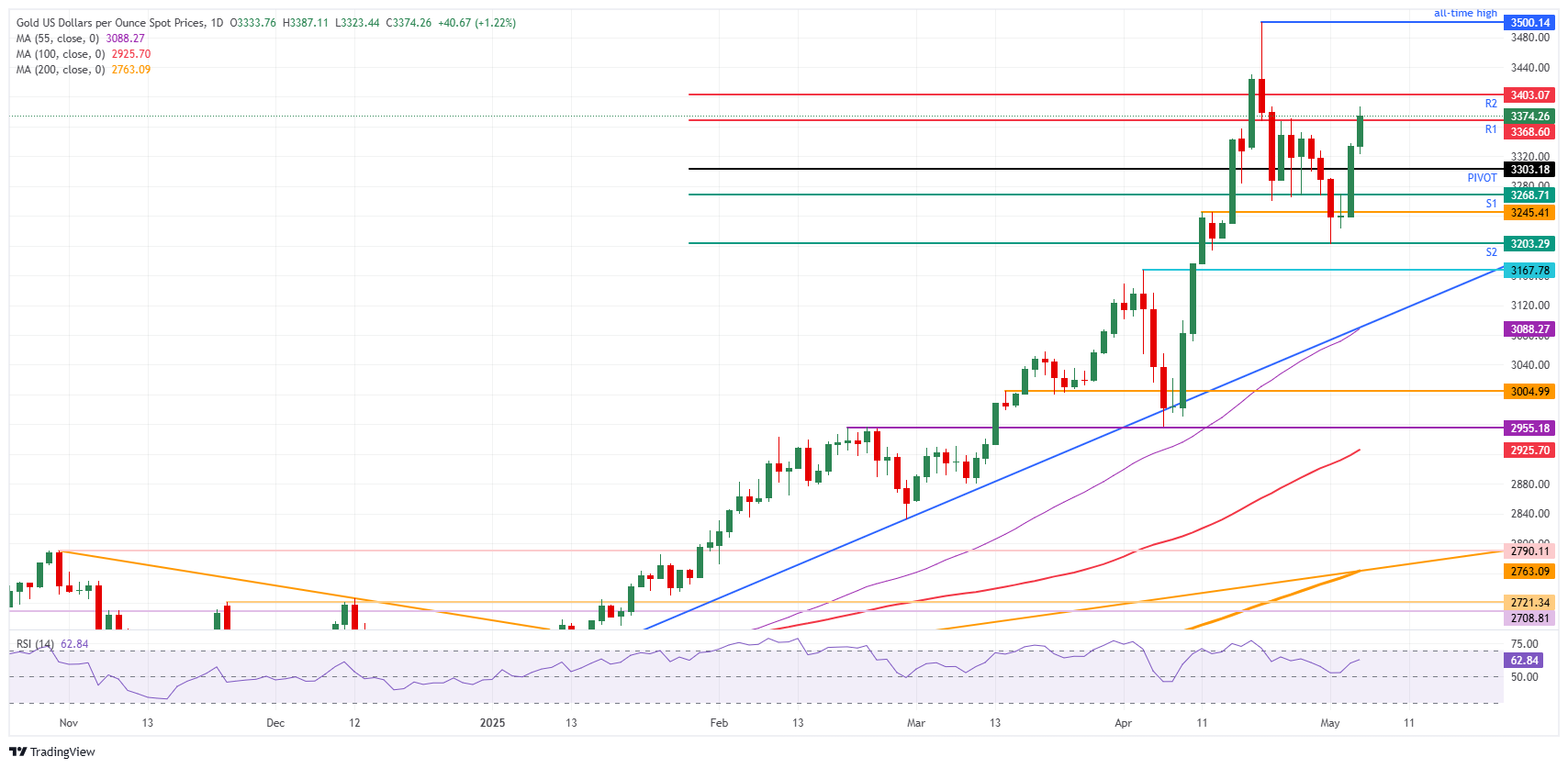Gold touches two-week high as safe-haven demand persists
- Gold extends gains, rising 3.8% in just two trading days.
- Geopolitical risks from the Trump administration, Asian currency turmoil and Israel are spurring investors to head back into Gold.
- Upside risks persist on several fronts, increasing the chances that Gold tests its all-time high at $3,500.
Gold (XAU/USD) sprints higher on Tuesday for a second consecutive day, as geopolitical tensions around the globe continue to support investors’ demand for safe-haven assets. In the Middle East, Israel is further preparing its ground offensive in the Gaza Strip with the aim of fully controlling the area.
In the United States (US), pressure is building on US President Donald Trump and his administration to finally announce a first trade deal. Trump and his cabinet have been very vocal about deals being imminent, with US Commerce Secretary Howard Lutnick saying that the first trade deal will be with a top ten economy, Fox News reported.
Meanwhile, some very sharp moves in the Forex market are also keeping investors on edge. Traders are trying to assess how to position themselves after the fallout of the Taiwan Dollar (TWD) move seen on Monday after it appreciated sharply against the US Dollar (USD). The bigger risk is having a domino effect on the US Dollar – which could weaken against other major Asian currencies – making it no longer a steady and reliable safe haven currency and thus benefiting Gold.
Daily digest market movers: What if and when…
- Market sentiment is improving a touch on Tuesday after the Taiwan Dollar (TWD) move on Monday, but the focus on Asian currencies persists. Saxo’s Chief Investment Strategist in Singapore, Charu Chanana, said that "the real action today is in Asian FX”. Chanana went on by saying that "If these currencies keep strengthening sharply, it could spark fears of a 'reverse Asian currency crisis', with potential ripple effects in the bond market amid fears that Asian institutions reassess their unhedged exposure to Treasury holdings," Reuters reports. Generally, Gold benefits when US bonds are starting to show lower yield returns for investors.
- The Shanghai Gold Exchange plans to expand its warehouse network to Hong Kong, helping to raise the profile of its yuan-denominated products, including for the precious metal beyond mainland China, Bloomberg reports.
- The CME FedWatch tool shows the chance of an interest rate cut by the Federal Reserve in May's meeting stands at 2.4% against a 97.6% probability of no change. The June meeting sees a 29.8% chance of a rate cut.
Gold Price Technical Analysis: Where is that first deal?
Gold price is rallying higher in what looks to be a second wave of safe haven inflow in the precious metal. Balances and powers in financial markets are shifting, and one of them seems to be the Greenback losing its status as a safe haven in benefit of Bullion. In this scenario, Gold is set to rocket higher should President Trump and his administration be unable to soon announce a trade deal with any country, preferably a G20 one.
On the upside, the R1 resistance at $3,368 has already been broken in a topside test in early trading this Tuesday. Should some follow-through come, the R2 resistance at $3,403 might see a test very swiftly. The all-time high at $3,500 might be a bit too far off for traders to test already on Tuesday.
On the downside, the Pivot Point at $3,303 is the first level to watch. Further down, the daily S1 support comes in at $3,268, coinciding with the lows of last week on April 30, 28, 25 and 23. The technical level at $3,245 should do the trick and hold in case of any sudden reversals.

XAU/USD: Daily Chart
Gold FAQs
Gold has played a key role in human’s history as it has been widely used as a store of value and medium of exchange. Currently, apart from its shine and usage for jewelry, the precious metal is widely seen as a safe-haven asset, meaning that it is considered a good investment during turbulent times. Gold is also widely seen as a hedge against inflation and against depreciating currencies as it doesn’t rely on any specific issuer or government.
Central banks are the biggest Gold holders. In their aim to support their currencies in turbulent times, central banks tend to diversify their reserves and buy Gold to improve the perceived strength of the economy and the currency. High Gold reserves can be a source of trust for a country’s solvency. Central banks added 1,136 tonnes of Gold worth around $70 billion to their reserves in 2022, according to data from the World Gold Council. This is the highest yearly purchase since records began. Central banks from emerging economies such as China, India and Turkey are quickly increasing their Gold reserves.
Gold has an inverse correlation with the US Dollar and US Treasuries, which are both major reserve and safe-haven assets. When the Dollar depreciates, Gold tends to rise, enabling investors and central banks to diversify their assets in turbulent times. Gold is also inversely correlated with risk assets. A rally in the stock market tends to weaken Gold price, while sell-offs in riskier markets tend to favor the precious metal.
The price can move due to a wide range of factors. Geopolitical instability or fears of a deep recession can quickly make Gold price escalate due to its safe-haven status. As a yield-less asset, Gold tends to rise with lower interest rates, while higher cost of money usually weighs down on the yellow metal. Still, most moves depend on how the US Dollar (USD) behaves as the asset is priced in dollars (XAU/USD). A strong Dollar tends to keep the price of Gold controlled, whereas a weaker Dollar is likely to push Gold prices up.

